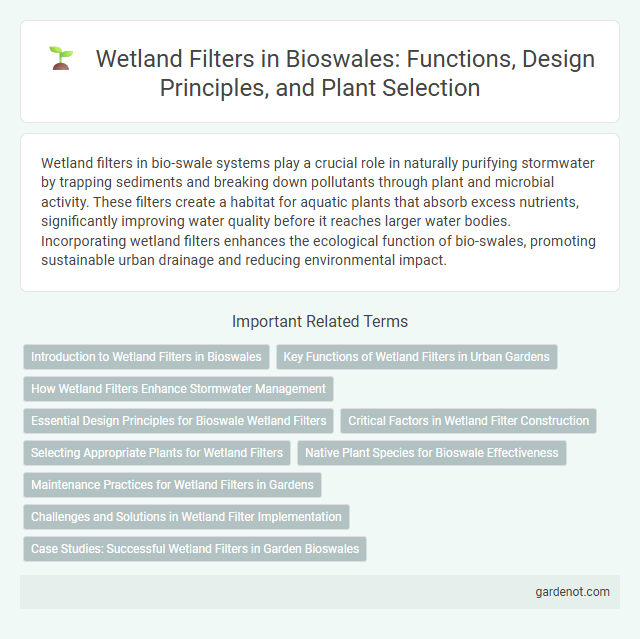Wetland filters in bio-swale systems play a crucial role in naturally purifying stormwater by trapping sediments and breaking down pollutants through plant and microbial activity. These filters create a habitat for aquatic plants that absorb excess nutrients, significantly improving water quality before it reaches larger water bodies. Incorporating wetland filters enhances the ecological function of bio-swales, promoting sustainable urban drainage and reducing environmental impact.
Introduction to Wetland Filters in Bioswales
Wetland filters in bioswales utilize natural vegetation and soil to trap and break down pollutants from stormwater runoff, improving water quality before it reaches waterways. These filters enhance the bioswale's capacity to retain sediments, nutrients, heavy metals, and pathogens through microbial activity and plant uptake. Incorporating wetland plants like cattails and sedges maximizes filtration efficiency while supporting biodiversity and habitat creation.
Key Functions of Wetland Filters in Urban Gardens
Wetland filters in urban gardens play a crucial role in improving water quality by naturally removing pollutants such as heavy metals, nitrates, and pathogens through sedimentation, filtration, and microbial activity. These systems enhance groundwater recharge while supporting biodiversity by providing habitats for native wetland plants and aquatic organisms. Their capacity to mitigate stormwater runoff reduces flooding risks and prevents harmful contaminants from entering municipal waterways.
How Wetland Filters Enhance Stormwater Management
Wetland filters enhance stormwater management by naturally removing pollutants such as sediments, nutrients, and heavy metals through biological, chemical, and physical processes. The vegetation and microbial activity within wetland systems improve water quality by trapping contaminants and facilitating their breakdown before stormwater reaches natural waterways. These systems also reduce peak runoff volumes and slow water flow, mitigating flood risks and promoting groundwater recharge.
Essential Design Principles for Bioswale Wetland Filters
Bioswale wetland filters rely on essential design principles such as optimal vegetation selection, proper soil media composition, and controlled flow rates to maximize pollutant removal and promote effective water infiltration. Incorporating native plant species with deep root systems enhances sediment capture and nutrient uptake, while engineered soil layers with high permeability ensure efficient filtration and microbial activity. Maintaining appropriate slope gradients and detention times facilitates sedimentation and biodegradation processes critical for improving stormwater quality in bioswale applications.
Critical Factors in Wetland Filter Construction
Wetland filter construction requires careful selection of native plant species that enhance pollutant removal through natural biofiltration processes. Soil composition and hydraulic retention time are critical factors influencing nutrient absorption and microbial activity within the wetland system. Proper grading and water flow management ensure optimal contact between contaminated water and vegetation, maximizing filtration efficiency in bio-swale applications.
Selecting Appropriate Plants for Wetland Filters
Selecting appropriate plants for wetland filters is crucial for maximizing pollutant removal and enhancing water quality. Native species such as cattails (Typha spp.), bulrushes (Schoenoplectus spp.), and sedges (Carex spp.) are effective due to their extensive root systems and tolerance to saturated conditions. These plants facilitate nutrient uptake, sediment stabilization, and support microbial communities essential for breaking down contaminants in bio-swales.
Native Plant Species for Bioswale Effectiveness
Native plant species in a bio-swale play a crucial role in enhancing wetland filter performance by improving water quality through natural filtration processes. These plants, adapted to local conditions, effectively trap sediments, absorb pollutants, and support microbial communities that break down contaminants. Integrating diverse native vegetation maximizes bioswale effectiveness by promoting ecosystem resilience and sustaining hydrological functions.
Maintenance Practices for Wetland Filters in Gardens
Regular inspection and removal of debris, sediment, and invasive plants are crucial for maintaining wetland filters in gardens. Ensuring consistent water flow and monitoring vegetation health promote optimal pollutant removal and habitat function. Periodic sediment excavation and adjusting plant species composition enhance the filter's efficiency in capturing nutrients and contaminants.
Challenges and Solutions in Wetland Filter Implementation
Wetland filters face challenges such as maintaining consistent water flow and preventing clogging due to sediment accumulation, which can reduce filtration efficiency. Solutions include designing adjustable inlet structures to manage variable inflow rates and implementing regular maintenance schedules to remove excess sediment and vegetation buildup. Incorporating diverse native plant species enhances pollutant uptake and resilience to fluctuating environmental conditions, improving overall wetland filter performance.
Case Studies: Successful Wetland Filters in Garden Bioswales
Case studies of garden bioswales with wetland filters demonstrate significant improvements in stormwater quality by effectively removing sediments, nutrients, and heavy metals. Notable examples include the Chesapeake Bay watershed projects, where constructed wetland filters reduced nitrogen and phosphorus runoff by up to 60%. These successful implementations highlight the critical role of engineered wetland systems in enhancing urban water management and supporting ecosystem health.
Wetland filter Infographic

 gardenot.com
gardenot.com